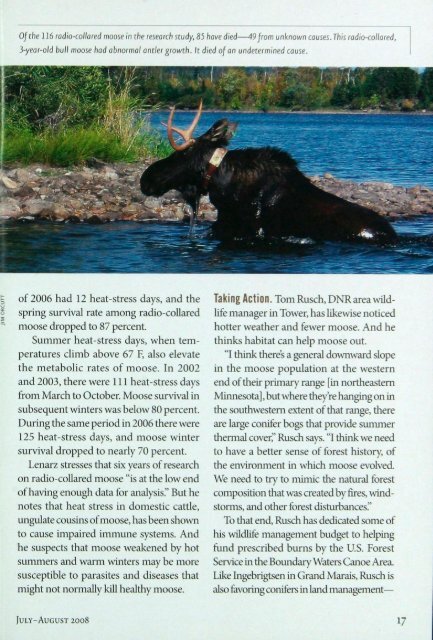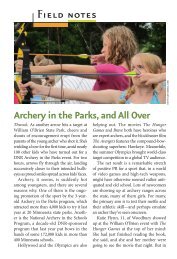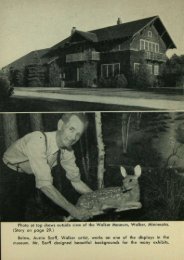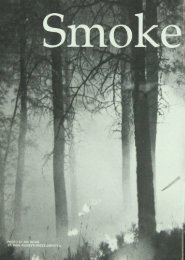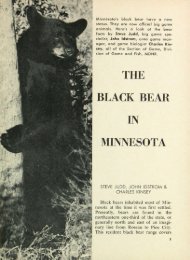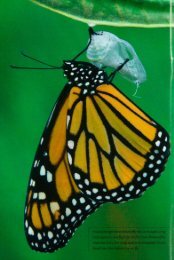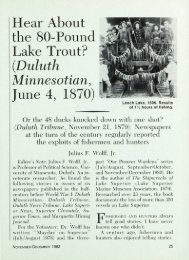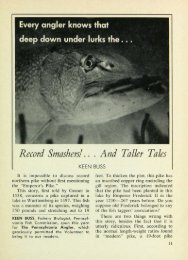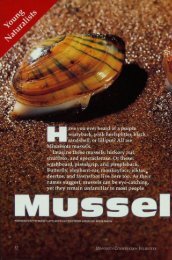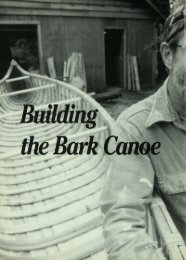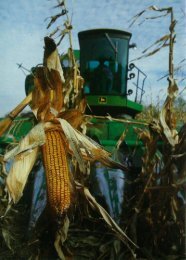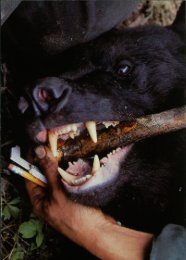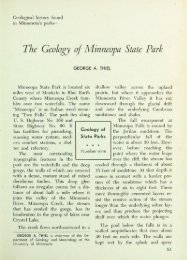4380 End of the Reign? - webapps8
4380 End of the Reign? - webapps8
4380 End of the Reign? - webapps8
Create successful ePaper yourself
Turn your PDF publications into a flip-book with our unique Google optimized e-Paper software.
Of <strong>the</strong> 116 radio-collared moose in <strong>the</strong> research study, 85 have died—49 from unknown causes. This radio-collared,<br />
3-year-old bull moose had abnormal antler growth. It died <strong>of</strong> an undetermined cause.<br />
| <strong>of</strong> 2006 had 12 heat-stress days, and <strong>the</strong><br />
u<br />
o spring survival rate among radio-collared<br />
" moose dropped to 87 percent.<br />
Summer heat-stress days, when temperatures<br />
climb above 67 F, also elevate<br />
<strong>the</strong> metabolic rates <strong>of</strong> moose. In 2002<br />
and 2003, <strong>the</strong>re were 111 heat-stress days<br />
from March to October. Moose survival in<br />
subsequent winters was below 80 percent.<br />
During <strong>the</strong> same period in 2006 <strong>the</strong>re were<br />
125 heat-stress days, and moose winter<br />
survival dropped to nearly 70 percent.<br />
Lenarz stresses that six years <strong>of</strong> research<br />
on radio-collared moose "is at <strong>the</strong> low end<br />
<strong>of</strong> having enough data for analysis." But he<br />
notes that heat stress in domestic cattle,<br />
ungulate cousins <strong>of</strong> moose, has been shown<br />
to cause impaired immune systems. And<br />
he suspects that moose weakened by hot<br />
summers and warm winters may be more<br />
susceptible to parasites and diseases that<br />
might not normally kill healthy moose.<br />
Taking Action. Tom Rusch, DNR area wildlife<br />
manager in Tower, has likewise noticed<br />
hotter wea<strong>the</strong>r and fewer moose. And he<br />
thinks habitat can help moose out.<br />
"I think <strong>the</strong>re's a general downward slope<br />
in <strong>the</strong> moose population at <strong>the</strong> western<br />
end <strong>of</strong> <strong>the</strong>ir primary range [in nor<strong>the</strong>astern<br />
Minnesota], but where <strong>the</strong>y're hanging on in<br />
<strong>the</strong> southwestern extent <strong>of</strong> that range, <strong>the</strong>re<br />
are large conifer bogs that provide summer<br />
<strong>the</strong>rmal cover," Rusch says. "I think we need<br />
to have a better sense <strong>of</strong> forest history, <strong>of</strong><br />
<strong>the</strong> environment in which moose evolved.<br />
We need to try to mimic <strong>the</strong> natural forest<br />
composition that was created by fires,windstorms,<br />
and o<strong>the</strong>r forest disturbances."<br />
To that end, Rusch has dedicated some <strong>of</strong><br />
his wildlife management budget to helping<br />
fund prescribed burns by <strong>the</strong> U.S. Forest<br />
Service in <strong>the</strong> Boundary Waters Canoe Area.<br />
Like Ingebrigtsen in Grand Marais, Rusch is<br />
also favoring conifers in land management—<br />
JULY-AUGUST 2008 17


